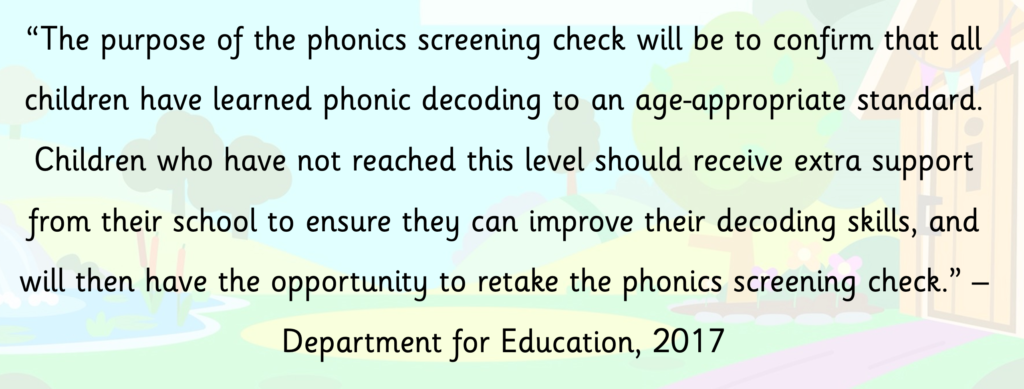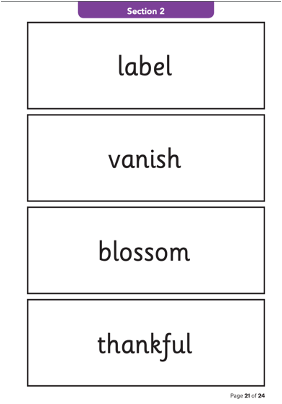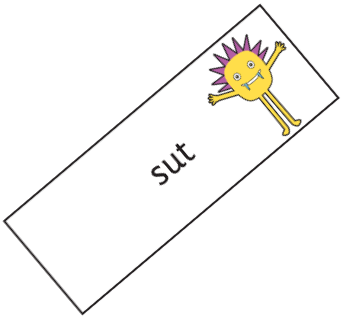About the Phonics Screening Check

What is it?
A statutory phonic knowledge screening for Year 1 pupils was introduced in 2011/12 in England.
It is conducted orally and 1:1 with teacher, usually lasts 5-10 minutes (although there is no set time limit). The test should be done with a teacher that the child knows to avoid unnecessary stress for the child.
The Year 1 Phonics Screening Check assessment usually takes place in June or at some point in the summer term.
It contains 40 words – two sections of 20 words. Both contain a mixture of real words and alien words.



Section 1 includes simple word structures and GPCs mainly drawn from Chapters 2 and 3.
Section 2 includes more complex word structures and GPCs mainly drawn from Chapters 4a and b; this can also include recognising alternative graphemes and phonemes in different words.
There will also be a few practice words first, to ensure that the child being assessed understands the activity.
Alien Words (pseudo-word)
A pseudo-word is word that looks like a word in a language as it uses GPCs and spellings that exist in that language. They are also sometimes referred to as ‘alien words’ or ‘nonsense words’. Examples include ‘melp’ and ‘wubbin’ as standard GPCs have been used to form words that don’t exist in standard English; however, ‘ckelm’ and ‘drellsch’ are not pseudo-words as they have not employed GPCs in commonly accepted places.


According to the DfE Phonics Screening Assessment Framework (2017): alien words provide the purest assessment of phonic decoding because there will be no bias based on visual memory of words or vocabulary knowledge.
The alien words will be presented with a picture of an imaginary creature and children will be asked to name the type of creature by decoding the word. The pictures of the aliens next to the words ensure that the children do not attempt to reconcile the alien words with words from their own vocabulary.
Preparing Pupils for the Phonics Screening Check
“A complete programme is one that provides all that is essential to teach SSP to children in reception and key stage 1 years of mainstream primary schools, up to or beyond the standards expected by the national curriculum, and provides sufficient support for them to become fluent readers.” (gov.uk)
Phonics Shed is a complete synthetic phonics program, validated by the DfE ensuring full coverage.





•Sound the word out, e.g. c-a-t. Be sure to use pure sounds here rather than letter names or ‘cuh’ etc – pure sounds.
•Squash the sounds together by saying them in order faster than before.
•Say the word that is made by squashing the sounds together.
A Narrative Driven Scheme
Schools who score highly in the Phonics Screening Check note that building a love of stories and reading plays a big part in their success (DfE, 2021). 2019 survey by the Literacy Trust found that children who enjoy reading were up to three times more likely to have higher than expected reading levels for their ages, and those who read daily are twice as likely to be above average in reading.
Since the 1960s, research has repeatedly shown that reading for pleasure is an indicator of reading ability. In fact, it was suggested in an international study that reading enjoyment and ability have more impact on children’s overall education than socio-economic factors.



High Frequency & Common Exception Words
Each HFW is linked to a Set and/or a specific sound to ensure that as many of the High Frequency Words (HFWs) as possible can be decoded and those that cannot yet be decoded can at least be partially decoded.
Words with bold letters are partially decodable common exception words (CEWs) that cannot yet be fully decoded, using the blending and segmenting technique, at this level. CEWs are linked to sets based on the frequency of their appearance (for example ‘the‘ is linked to Ch2 Set 1) or that they contain a letter that is being covered which represents a different sound (e.g. when ‘o’ is introduced, ‘do‘, ‘to‘, ‘no‘, ‘go‘ and ’so‘ follow on).


